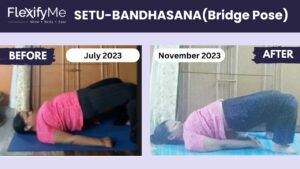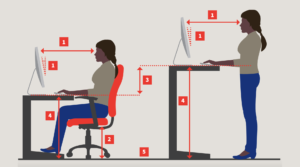Table of Contents
Understanding Lower Back Pain: From Aching Discomfort to Seeking Solutions
Lower back pain – it’s an unwelcome companion that millions of us have encountered at some point. It can range from a dull ache to a sharp, shooting pain, making even simple tasks like bending or walking feel like a chore. While the experience of lower back pain is unique to each individual, understanding its potential causes and knowing when to seek help are crucial steps towards finding relief.
Common Culprits Behind Back Pain:
- The Posture Patrol: Slouching, hunching, and improper lifting techniques can strain the muscles and ligaments supporting your spine, leading to pain. Imagine your spine as a complex suspension bridge – proper posture ensures everything stays balanced and supported, while bad posture creates tension and instability.
- Muscle Mayhem: Overexerting yourself, doing repetitive motions, or lifting heavy objects can cause tears or pulls in your lower back muscles. Think of your muscles as hardworking cables – overloading them can lead to strains and tears.
- Spinal Disc Drama: Herniated or bulging discs, where the soft inner material pushes through the tougher outer casing, can irritate surrounding nerves, causing pain, numbness, and weakness. Imagine the discs as cushions between your vertebrae – when they become damaged, they can pinch nerves and cause discomfort.
- Arthritis: The Wear and Tear Woe: Degenerative changes in the joints of the spine can lead to inflammation, stiffness, and pain. Think of your joints as the hinges of your body – over time, they can wear down and become painful.
- Injury’s Unwelcome Impact: Accidents, falls, and sports injuries can damage muscles, ligaments, bones, and discs in the lower back, causing pain and limited mobility. Just like a twisted ankle, an injured back needs proper care and attention.
Signs Your Back Needs Attention:
- A persistent ache or sharp pain in your lower back
- Pain that radiates down your buttocks, legs, or feet
- Muscle stiffness and tightness that makes movement difficult
- Trouble bending, twisting, or standing for extended periods
- Numbness or weakness in your legs
When to Seek Professional Help:
While occasional back pain may resolve with rest and self-care, it’s crucial to seek professional guidance if:
- The pain is severe or doesn’t improve after a few days.
- You experience difficulty walking, standing, or sitting.
- You have numbness, tingling, or weakness in your legs.
- You have difficulty controlling your bowels or bladder.
- You have a fever or unexplained weight loss.
Consulting a doctor or physical therapist can help diagnose the source of your back pain and recommend the best treatment plan, which may involve:
- Rest and Pain Relief: Over-the-counter pain relievers and short-term use of prescription medications can help manage pain and inflammation.
- Physical Therapy: Your Movement Ally: Exercises and stretches can strengthen your core muscles, improve flexibility, and promote healing. Think of it as physical therapy re-educating your body to move efficiently and pain-free.
- Manual Therapy: Lending a Hand (or Two): Techniques like massage therapy and chiropractic adjustments can help alleviate muscle tension and improve joint mobility. Imagine a massage therapist like a skilled mechanic, loosening tight muscles and improving joint range of motion.
- Lifestyle Changes: Taking Control: Maintaining good posture, practicing proper lifting techniques, and achieving a healthy weight can significantly reduce the risk of future back pain. These lifestyle changes empower you to take charge of your back health and prevent future discomfort.
Remember, early diagnosis and intervention are key to managing lower back pain effectively and preventing further complications. Don’t hesitate to reach out to a healthcare professional if you experience any concerning back pain symptoms. Taking care of your back is an investment in your overall well-being and quality of life.
Move It or Lose It: Why Exercise is Your Back Pain’s Worst Enemy (and Best Friend)
Lower back pain – it can turn even the simplest tasks like bending down to pick up your keys into an unwelcome adventure. But fear not, fellow sufferers! While medications and rest can offer temporary relief, there’s a powerful weapon in your arsenal that can help you fight back pain for good: exercise.
Now, before you start picturing yourself lifting heavy weights at the gym (which might not be the best idea!), hear me out. Exercise for back pain isn’t about pushing yourself to the limit. It’s about strategic movement that strengthens your core, improves flexibility, and even helps manage pain naturally.
So, how exactly does exercise work its magic?
- Building a Strong Foundation: Think of your core muscles as your spine’s personal bodyguards. Exercises like planks and bridges help strengthen these muscles, improving their ability to support your spine and reduce strain.
- Loosening Up the Tightness: Tight muscles can be like angry little gremlins, pulling on your joints and contributing to pain. Stretching exercises like knee-to-chest stretches and hamstring stretches help loosen these muscles, allowing for better movement and less discomfort.
- Natural Pain Relief: Exercise is like a built-in pain reliever! When you move your body, it releases endorphins, your body’s natural feel-good chemicals. These endorphins can help elevate your mood and manage pain perception, making you feel better overall.
Okay, I’m convinced exercise is good, but what kind of exercises should I do?
The beauty of exercise for back pain is that there are options for everyone! Here are a few examples:
- Core Builders: These exercises target your abdominal and back muscles, creating a strong foundation for your spine. Think planks, bird-dogs, and supermans – superhero names not included, but optional for added motivation.
- Lumbar Stabilizers: These exercises focus on the muscles in your lower back, improving stability and reducing the risk of injury. Side planks and dead bugs are great examples, and the names sound way cooler than they actually are, I promise.
- Cardio Champs: Activities like walking, swimming, and cycling get your heart rate up and improve blood flow. This helps deliver nutrients to your muscles and joints, promoting healing and pain relief.
Remember: Before starting any new exercise program, especially if you have any pre-existing health conditions, it’s crucial to consult with a healthcare professional. They can help you create a personalized plan that’s safe and effective for your specific needs.
So, the next time you’re dealing with back pain, don’t just reach for the painkillers. Consider incorporating some gentle exercises into your routine. You might be surprised at how effective they can be in helping you move better, feel better, and ultimately, win the battle against back pain.
Conquer Back Pain with These Effective Exercises (You Can Do Them at Home!)
Think of it like this: Your spine is like a complex bridge, and the muscles around it are the support beams. When these muscles are weak or tight, the bridge becomes unstable, and pain can arise. Exercise helps strengthen these support beams, taking the stress off your spine and promoting better overall function.
So, how do we get started? Here are some exercises you can easily do at home, along with some visual aids to help you master the proper form:
Stretches:
- Knee-to-Chest Stretch:
This gentle stretch loosens tight hamstrings and glutes, which can contribute to lower back pain.

Image of Knee-to-chest stretch:
- Lie on your back with both knees bent and feet flat on the floor.
- Gently hug one knee to your chest, holding for 30 seconds and breathing deeply.
- Repeat with the other leg.
- Hamstring Stretch:
Tight hamstrings can pull on your lower back, so this stretch is crucial.

Image of Hamstring stretch:
- Lie on your back with both legs extended.
- Loop a towel or yoga strap around one foot and gently pull it towards you, straightening the leg towards the ceiling.
- Hold for 30 seconds, feeling the stretch in your hamstrings.
- Repeat with the other leg.
- Piriformis Stretch:
This stretch targets the piriformis muscle, which can sometimes cause sciatic nerve pain.

Image of Piriformis stretch:
- Lie on your back with both knees bent and feet flat on the floor.
- Cross your right ankle over your left knee, placing your right foot on top of your left thigh.
- Gently pull your left knee towards your chest, feeling the stretch in your right buttock.
- Hold for 30 seconds, breathing deeply.
- Repeat on the other side.
Strengthening Exercises:
- Bridge Exercise:
This exercise strengthens your glutes and core, improving stability and reducing back pain.

Image of Bridge exercise:
- Lie on your back with knees bent and feet flat on the floor, hip-width apart.
- Lift your hips off the ground, squeezing your glutes and forming a straight line from your shoulders to your knees.
- Hold for 5-10 seconds, then slowly lower yourself back down.
- Repeat 10-15 times.
- Plank:
Planks are a fantastic core exercise that strengthens your entire midsection, providing better support for your spine.

Image of Plank exercise:
- Start on your forearms with elbows shoulder-width apart, forearms flat on the floor.
- Engage your core by drawing your belly button towards your spine.
- Raise your body off the ground, forming a straight line from your head to your heels.
- Hold for as long as you can comfortably, aiming for 30 seconds to 1 minute with practice.
- Bird Dog:
This exercise improves core stability and coordination, helping to prevent future back pain.

Image of Bird dog exercise:
- Start on all fours, hands directly under shoulders and knees hip-width apart.
- Extend one arm forward and the opposite leg backward, keeping your back flat and core engaged.
- Hold for 5 seconds, then return to starting position.
- Repeat on the other side.
- Do 10-12 repetitions on each side.
Aerobic Activities:
While these exercises are great for improving flexibility and strength, incorporating some low-impact cardio is also crucial for overall back health. Here are some ideas:
- Walking: It’s simple, free, and effective. Aim for 30 minutes of brisk walking most days of the week.
- Swimming: The buoyancy of water takes pressure off your joints, making it an excellent choice for low-impact exercise. Swimming engages various muscle groups and promotes flexibility.
- Low-impact aerobics: Look for online exercise videos or classes designed specifically for low-impact aerobics, which offer cardiovascular benefits without putting stress on your back.
Remember: Consistency is key! Aim to incorporate these exercises into your routine 2-3 times a week, gradually increasing the duration and intensity as you feel comfortable. Listen to your body, and if you experience any pain, stop the exercise and consult a healthcare professional.
Bonus Tip: Maintaining good posture throughout the day can significantly reduce back pain. Here are some simple tips:
- Stand tall with your shoulders back and relaxed, and your core engaged.
- Avoid slouching while sitting, and use a supportive chair with good lumbar support.
- When lifting objects, bend your knees and use your leg muscles to lift, not your back.
By incorporating these exercises, stretches, and tips into your routine, you can take control of your back pain and move towards a healthier, pain-free you!
Conquer Back Pain: Beyond Exercise and Into Your Everyday Life
Back pain can be a real drag, but don’t despair! While exercise is a powerful tool, it’s not the only weapon in your back pain arsenal. Here are some additional lifestyle changes you can incorporate to empower yourself and take control of your back health:
1. Stand Tall and Be Proud: Embrace Good Posture
Think of good posture as a superpower for your back. Standing tall with your shoulders back and relaxed, core engaged, and chin tucked slightly in helps distribute weight evenly throughout your body, reducing stress on your spine. Here are some practical tips:
- Sitting: Choose a chair with good lumbar support and avoid slouching. Keep your knees at a 90-degree angle and feet flat on the floor. Imagine a string pulling you up from your head throughout the day, especially when using electronics or driving.
- Standing: Distribute your weight evenly on both feet, avoid locking your knees, and take micro-movements like shifting your weight or rolling your ankles to prevent stiffness.
2. Make Your Workspace Your Ally: Embrace Ergonomics
If you have a desk job, creating an ergonomic workspace can be a game-changer. Here’s how to transform your desk into a back-friendly zone:
- Chair Height: Adjust your chair so your knees are bent at a 90-degree angle and your feet are flat on the floor.
- Monitor Magic: Ensure your monitor is at eye level to avoid neck strain. Invest in a monitor stand if needed.
- Lumbar Love: Invest in a supportive lumbar cushion for your chair.
- Movement Matters: Take frequent breaks to get up and move around, even if it’s just for a few minutes. Stretch, walk around, or do some simple desk exercises.
3. De-Stress for a Healthier Back
Chronic stress can be a major contributor to back pain. Finding healthy ways to manage stress can be highly beneficial. Here are some ideas to de-stress and conquer tension:
- Relaxation Techniques: Deep breathing exercises, meditation, and progressive muscle relaxation can all help reduce stress and promote relaxation. There are many free apps and online resources available to guide you.
- Do What Makes You Smile: Make time for hobbies, social activities, or anything that brings you joy and helps you de-stress. Whether it’s reading, spending time in nature, or listening to music, prioritize activities that bring you peace.
- Seek Help When Needed: If you’re struggling to manage stress on your own, consider talking to a therapist or counselor. They can provide valuable support and equip you with effective coping mechanisms.
4. Maintain a Healthy Weight for a Healthy Back
Carrying excess weight puts additional strain on your spine and joints, increasing your risk of back pain. Losing weight, even a small amount, can significantly improve your back health. Here are some pointers:
- Seek Professional Guidance: Consult your doctor or a registered dietitian to develop a safe and effective weight loss plan tailored to your individual needs.
- Focus on Healthy Habits: Make healthy dietary choices and incorporate regular physical activity into your routine. Small, sustainable changes are key to long-term success.
5. Prioritize Sleep for Optimal Recovery
When you don’t get enough sleep, your body doesn’t have enough time to heal and repair itself, which can worsen back pain. Aim for 7-8 hours of quality sleep each night. Here are some tips to create a sleep sanctuary:
- Develop a Relaxing Routine: Wind down before bed with calming activities like reading, taking a warm bath, or listening to calming music.
- Optimize Your Sleep Environment: Ensure your bedroom is dark, quiet, and cool. Invest in blackout curtains, earplugs, and a comfortable mattress and pillows.
- Stick to a Schedule: Develop a consistent sleep schedule and stick to it as much as possible, even on weekends. This helps regulate your body’s natural sleep-wake cycle.
Remember: Consistency is key! By incorporating these tips into your daily routine, you can empower yourself to manage back pain and experience lasting relief.
Additional Resources:
Bonus Tip: Consider exploring alternative therapies like yoga, massage therapy, or acupuncture, always consulting your healthcare professional before trying any new therapy. Additionally, investing in a supportive mattress and chair can significantly improve your back comfort and reduce pain.
Conquer Back Pain for Good: Embrace an Active Lifestyle with FlexifyMe
Hey there, back pain warriors! We’ve been in the trenches together, wrestling with stiffness and wincing at everyday movements. We’ve talked about powerful exercise routines and explored lifestyle tweaks to keep back pain at bay. But remember, managing back pain is an ongoing journey, not a quick fix.
The good news? You’re not alone in this fight. By adopting an active lifestyle and incorporating the tips we’ve discussed, you can significantly improve your condition and prevent future flare-ups. Here’s the key: consistency is your best friend. Regularly practicing these strategies, whether it’s daily exercise, maintaining good posture, or managing stress, is the recipe for lasting results.
Now, you might be thinking, “Okay, I’m convinced, but where do I start?”
This is where FlexifyMe steps in as your supportive partner on your back pain management journey. We offer personalized exercise programs designed specifically for your needs, crafted by certified trainers and powered by cutting-edge AI technology. Imagine the convenience of having tailored workouts readily available at home, combined with the expertise of professionals guiding you every step of the way.
FlexifyMe takes the guesswork out of managing back pain. No more scouring the internet for generic exercises or wondering if you’re doing them correctly. Our programs are designed to fit your unique needs and fitness level, providing a safe and effective way to strengthen your core, improve flexibility, and ultimately, conquer back pain.Ready to take control and embrace an active lifestyle? Explore FlexifyMe and discover the potential to move towards a healthier, pain-free future. Remember, you’ve got this! And FlexifyMe is here to support you every step of the way.


